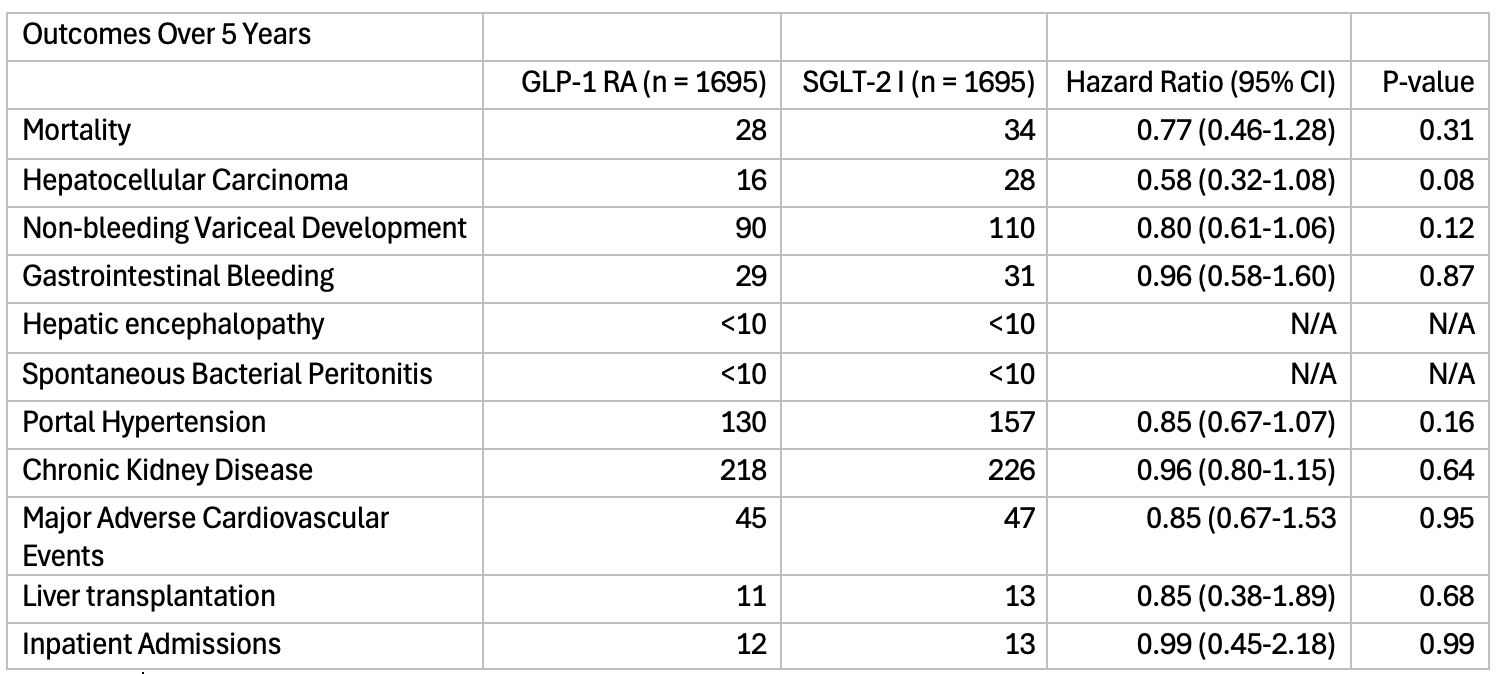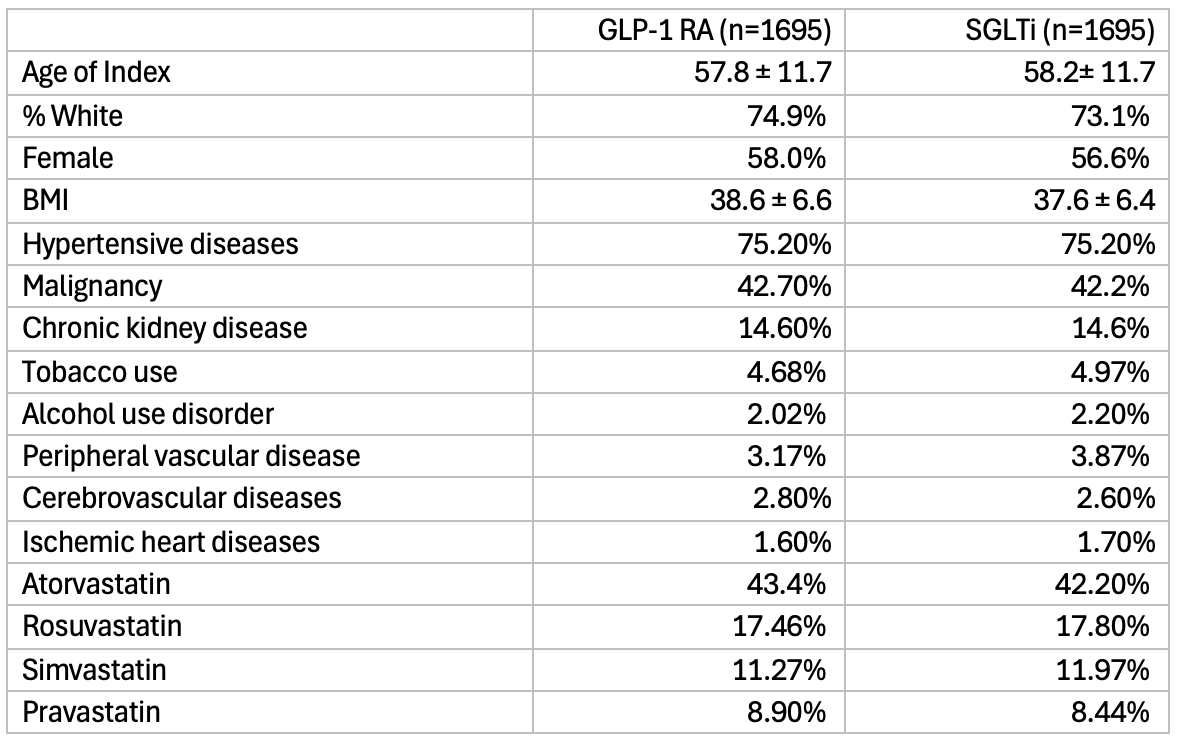Monday Poster Session
Category: Liver
P3640 - Comparative Effectiveness of Initiating GLP-1 Receptor Agonists (GLP-1 RAs) vs SGLT-2 Inhibitors (SGLT2is) in Patients With Compensated MASLD Cirrhosis and Type 2 Diabetes: A Global Retrospective Analysis
Monday, October 27, 2025
10:30 AM - 4:00 PM PDT
Location: Exhibit Hall

Varun Aitharaju, MD
Cleveland Clinic Foundation
Cleveland, OH
Presenting Author(s)
Varun Aitharaju, MD1, Mohamad Mahdi Osman, DO2, Humza Khan, MD3, Stephen Firkins, MD4, Roberto Simons-Linares, MD4
1Cleveland Clinic Foundation, Cleveland, OH; 2Cleveland Clinic, Cleveland, OH; 3Case Western Reserve University / MetroHealth, Cleveland, OH; 4Gastroenterology and Hepatology, Cleveland Clinic, Cleveland, OH
Introduction: Metabolic dysfunction-associated steatotic liver disease (MASLD) is a leading cause of chronic liver disease worldwide, affecting up to 30% of the global population. Progression to MASLD cirrhosis significantly increases the risk of liver transplantation and mortality. There are preliminary observational studies that suggest that in patients with MASLD cirrhosis and type 2 diabetes, both GLP-1 RAs and SGLT-2is may reduce decompensation and provide a mortality benefit. However, direct comparative data between these drug classes in this population group remain limited.
This study aims to compare mortality among patients who were prescribed GLP-1 RAs and SGLT-2 inhibitors after diagnosis of MASLD cirrhosis. Secondary outcomes include comparing the incidence of hepatocellular carcinoma (HCC), hepatic decompensation, inpatient admission, major adverse cardiac events (MACE), chronic kidney disease, and liver transplantation.
Methods: A retrospective analysis was conducted using the multi-institutional research network TriNetX. All adult patients with a diagnosis of fibrosis and cirrhosis, type 2 diabetes, and a BMI of 30-70 kg/m2 were included. Patients with a prior diagnosis of HCC, varices, encephalopathy, ascites, spontaneous bacterial peritonitis (SBP), and portal hypertension were excluded. Additionally, patients with a diagnosis of cirrhosis from other etiologies (infectious, alcoholic, autoimmune, hemochromatosis, and Wilson’s disease) were excluded. The patients were propensity matched for age, sex, comorbidities, BMI, and statin use. Baseline characteristics are presented in Table 1. Multivariable-adjusted Cox proportional hazards models were used to compare outcomes.
Results: After propensity matching, 1695 patients were included in each treatment arm. Five years later, there was no difference in mortality between GLP-1 RA and SGLT-2i users (Hazard Ratio [HR] 0.77; 95% Confidence Interval [CI] 0.46-1.28). There were additionally no differences in the incidence of HCC, non-variceal bleeding development, gastrointestinal bleeding, portal hypertension, chronic kidney disease, MACE, liver transplant, and inpatient admission (P >0.05) as shown in Table 2.
Discussion: Among patients with compensated MASLD cirrhosis and type 2 diabetes, GLP-1 RAs and SGLT-2is appear to demonstrate comparable outcomes in terms of mortality and liver-related complications. Future prospective studies are needed to more clearly understand the roles of these drugs in these patient populations.

Figure: Table 1. Baseline characteristics of patients in both groups.

Figure: Table 2. Primary and secondary outcomes of both groups after 5 years.
Disclosures:
Varun Aitharaju indicated no relevant financial relationships.
Mohamad Mahdi Osman indicated no relevant financial relationships.
Humza Khan indicated no relevant financial relationships.
Stephen Firkins indicated no relevant financial relationships.
Roberto Simons-Linares indicated no relevant financial relationships.
Varun Aitharaju, MD1, Mohamad Mahdi Osman, DO2, Humza Khan, MD3, Stephen Firkins, MD4, Roberto Simons-Linares, MD4. P3640 - Comparative Effectiveness of Initiating GLP-1 Receptor Agonists (GLP-1 RAs) vs SGLT-2 Inhibitors (SGLT2is) in Patients With Compensated MASLD Cirrhosis and Type 2 Diabetes: A Global Retrospective Analysis, ACG 2025 Annual Scientific Meeting Abstracts. Phoenix, AZ: American College of Gastroenterology.
1Cleveland Clinic Foundation, Cleveland, OH; 2Cleveland Clinic, Cleveland, OH; 3Case Western Reserve University / MetroHealth, Cleveland, OH; 4Gastroenterology and Hepatology, Cleveland Clinic, Cleveland, OH
Introduction: Metabolic dysfunction-associated steatotic liver disease (MASLD) is a leading cause of chronic liver disease worldwide, affecting up to 30% of the global population. Progression to MASLD cirrhosis significantly increases the risk of liver transplantation and mortality. There are preliminary observational studies that suggest that in patients with MASLD cirrhosis and type 2 diabetes, both GLP-1 RAs and SGLT-2is may reduce decompensation and provide a mortality benefit. However, direct comparative data between these drug classes in this population group remain limited.
This study aims to compare mortality among patients who were prescribed GLP-1 RAs and SGLT-2 inhibitors after diagnosis of MASLD cirrhosis. Secondary outcomes include comparing the incidence of hepatocellular carcinoma (HCC), hepatic decompensation, inpatient admission, major adverse cardiac events (MACE), chronic kidney disease, and liver transplantation.
Methods: A retrospective analysis was conducted using the multi-institutional research network TriNetX. All adult patients with a diagnosis of fibrosis and cirrhosis, type 2 diabetes, and a BMI of 30-70 kg/m2 were included. Patients with a prior diagnosis of HCC, varices, encephalopathy, ascites, spontaneous bacterial peritonitis (SBP), and portal hypertension were excluded. Additionally, patients with a diagnosis of cirrhosis from other etiologies (infectious, alcoholic, autoimmune, hemochromatosis, and Wilson’s disease) were excluded. The patients were propensity matched for age, sex, comorbidities, BMI, and statin use. Baseline characteristics are presented in Table 1. Multivariable-adjusted Cox proportional hazards models were used to compare outcomes.
Results: After propensity matching, 1695 patients were included in each treatment arm. Five years later, there was no difference in mortality between GLP-1 RA and SGLT-2i users (Hazard Ratio [HR] 0.77; 95% Confidence Interval [CI] 0.46-1.28). There were additionally no differences in the incidence of HCC, non-variceal bleeding development, gastrointestinal bleeding, portal hypertension, chronic kidney disease, MACE, liver transplant, and inpatient admission (P >0.05) as shown in Table 2.
Discussion: Among patients with compensated MASLD cirrhosis and type 2 diabetes, GLP-1 RAs and SGLT-2is appear to demonstrate comparable outcomes in terms of mortality and liver-related complications. Future prospective studies are needed to more clearly understand the roles of these drugs in these patient populations.

Figure: Table 1. Baseline characteristics of patients in both groups.

Figure: Table 2. Primary and secondary outcomes of both groups after 5 years.
Disclosures:
Varun Aitharaju indicated no relevant financial relationships.
Mohamad Mahdi Osman indicated no relevant financial relationships.
Humza Khan indicated no relevant financial relationships.
Stephen Firkins indicated no relevant financial relationships.
Roberto Simons-Linares indicated no relevant financial relationships.
Varun Aitharaju, MD1, Mohamad Mahdi Osman, DO2, Humza Khan, MD3, Stephen Firkins, MD4, Roberto Simons-Linares, MD4. P3640 - Comparative Effectiveness of Initiating GLP-1 Receptor Agonists (GLP-1 RAs) vs SGLT-2 Inhibitors (SGLT2is) in Patients With Compensated MASLD Cirrhosis and Type 2 Diabetes: A Global Retrospective Analysis, ACG 2025 Annual Scientific Meeting Abstracts. Phoenix, AZ: American College of Gastroenterology.
